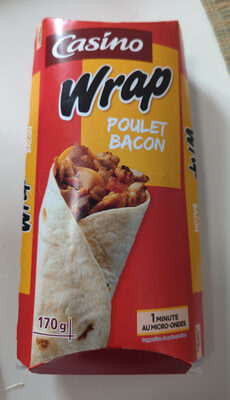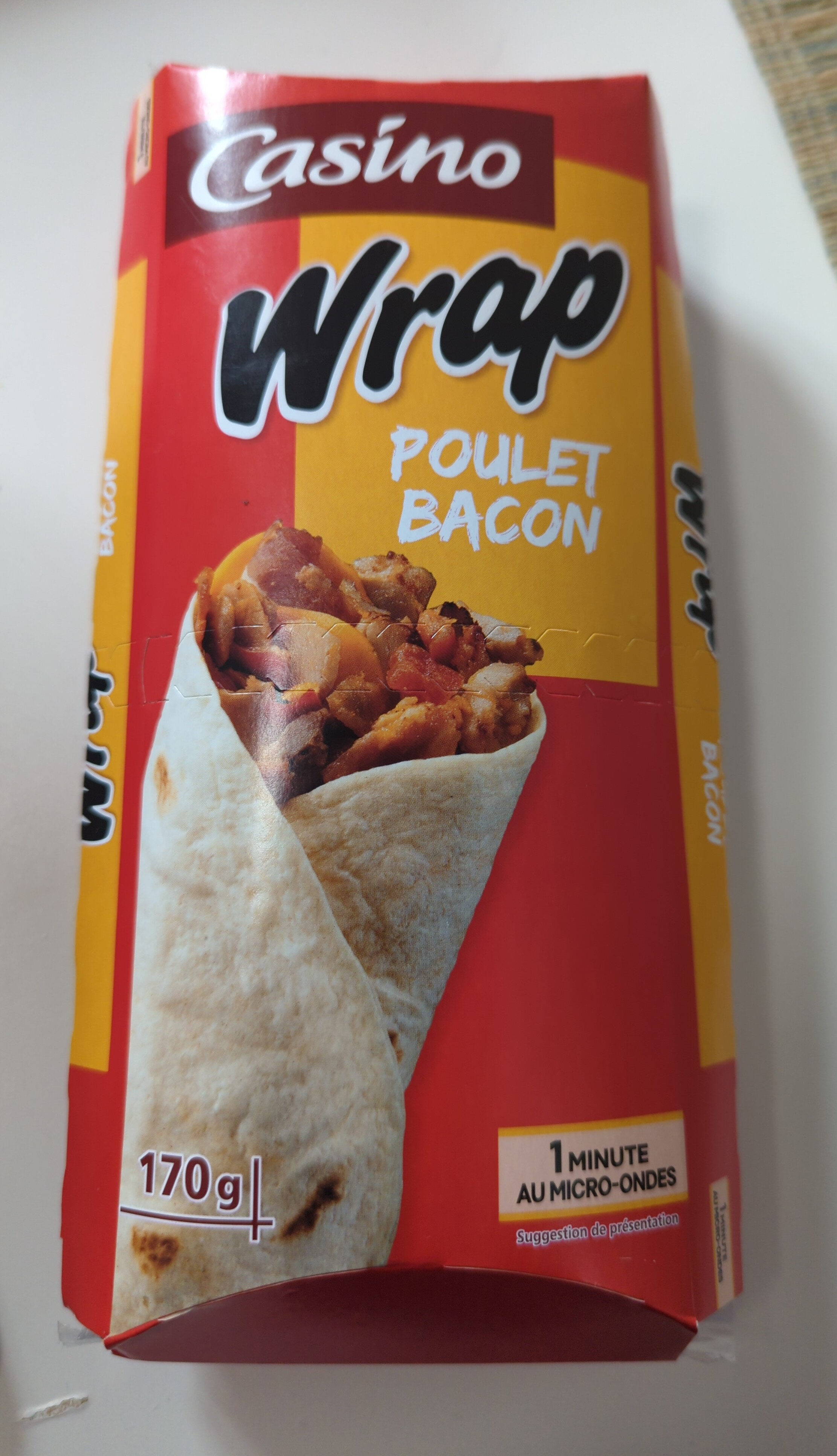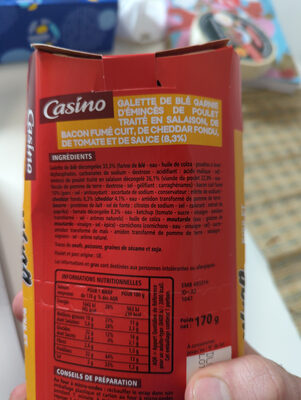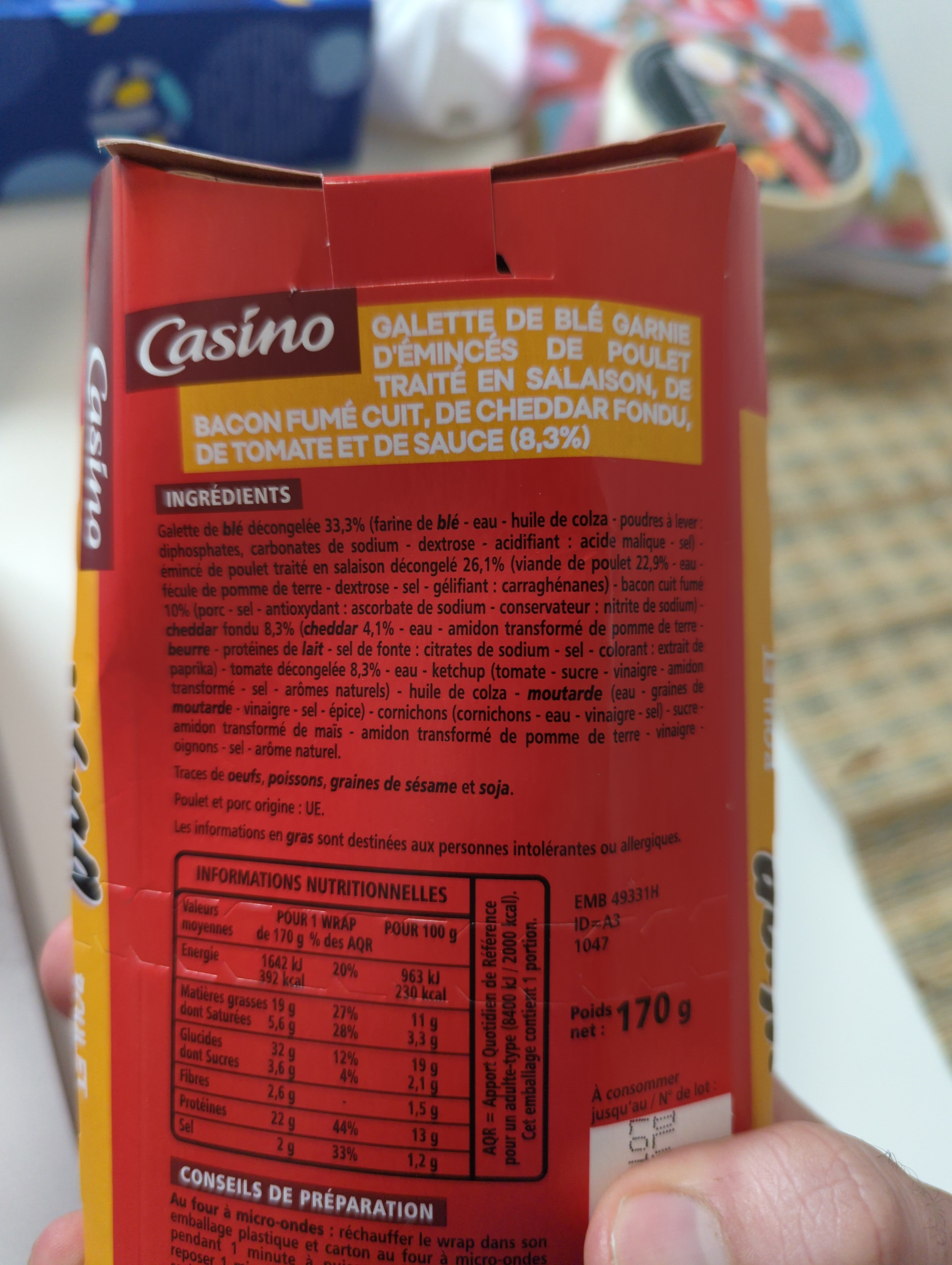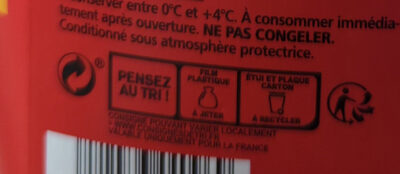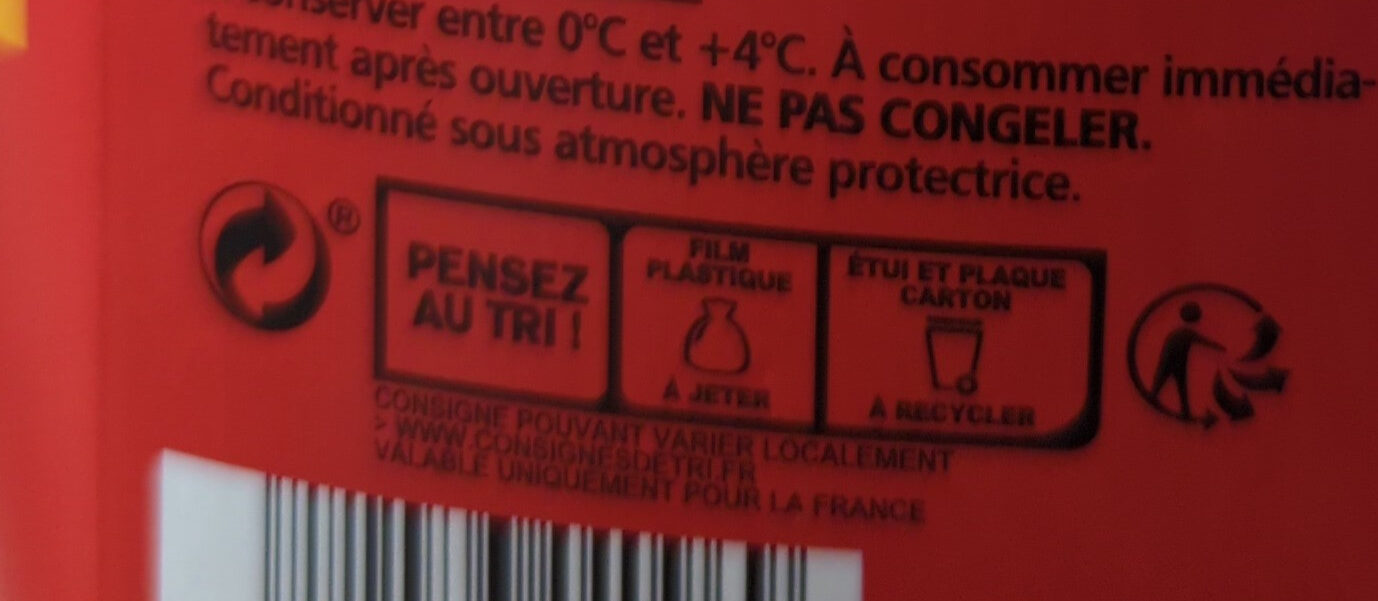Help us make food transparency the norm!
As a non-profit organization, we depend on your donations to continue informing consumers around the world about what they eat.
The food revolution starts with you!
Wrap poulet bacon - Casino - 170 g
Wrap poulet bacon - Casino - 170 g
This product page is not complete. You can help to complete it by editing it and adding more data from the photos we have, or by taking more photos using the app for Android or iPhone/iPad. Thank you!
×
Some of the data for this product has been provided directly by the manufacturer casino.
Barcode: 3222476440969 (EAN / EAN-13)
Common name: Galette de blé garnie de viande de cuisse de poulet traitée en salaison rôtie, de bacon fumé cuit, de cheddar orange fondu, de tomate et de sauce (8,8%)
Quantity: 170 g
Packaging: fr:Film en plastique, fr:Plaque en carton
Brands: Casino
Categories: Sandwiches, Wraps
Labels, certifications, awards:
Green Dot
Traceability code: EMB 49331H - Segré (Maine-et-Loire, France)
Stores: Casino
Countries where sold: France
Matching with your preferences
Health
Ingredients
-
88 ingredients
: Galette de blé décongelé 35,3% (farine de blé - eau - huile de colza - poudres à lever : diphosphates, carbonates de sodium - dextrose - acidifiant : acide malique - sel) - viande de cuisse de poulet traitée en salaison rôtie 27,7% (viande de poulet 22,4% - eau - huile de tournesol - acidifiant : lactate de potassium - sel - protéines de soja - dextrose - arômes naturels - gélifiant : carraghénanes - arôme naturel d'ail avec autres arômes naturels) - bacon fumé au bois de hêtre cuit décongelé 10,6% (viande de porc - eau - sel - antioxydant : ascorbate de sodium - conservateur : nitrite de sodium) - cheddar orange fondu 8,8% (cheddar orange 4,4% - fromages - eau - beurre - protéines de lait - amidon transformé de maïs - émulsifiants : citrates de sodium, polyphosphates - lactosérum - sel - arôme - gélifiant : carraghénanes - colorant : rocou) - tomate décongelée 8,8% - eau - ketchup (concentré de tomate - sirop de glucose-fructose - vinaigre d'alcool - sucre - amidon transformé de maïs - sel - acidifiant : acide lactique - épices) - huile de colza - moutarde (eau - graines de moutarde - vinaigre d'alcool - sel - épices - arômes - conservateur : sulfite acide de sodium) - cornichons (cornichons - vinaigre d'alcool - sel) - sucre - amidon transformé de maïs - vinaigre d'alcool - concentré de tomates - oignons déshydratés - sel - conservateur : sorbate de potassium - arôme naturel - colorant : extrait de paprika. Traces de poissons, œufs, fruits à coque et graines de sésame. Poulet et porc origine : UE.Allergens: Gluten, Milk, Mustard, SoybeansTraces: Eggs, Fish, Nuts, Sesame seeds
Food processing
-
Ultra processed foods
Elements that indicate the product is in the 4 - Ultra processed food and drink products group:
- Additive: E14XX - Modified Starch
- Additive: E160b - Annatto
- Additive: E160c - Paprika extract
- Additive: E326 - Potassium lactate
- Additive: E407 - Carrageenan
- Additive: E450 - Diphosphates
- Additive: E452 - Polyphosphates
- Ingredient: Colour
- Ingredient: Dextrose
- Ingredient: Emulsifier
- Ingredient: Flavouring
- Ingredient: Gelling agent
- Ingredient: Glucose
- Ingredient: Milk proteins
- Ingredient: Whey
Food products are classified into 4 groups according to their degree of processing:
- Unprocessed or minimally processed foods
- Processed culinary ingredients
- Processed foods
- Ultra processed foods
The determination of the group is based on the category of the product and on the ingredients it contains.
Additives
-
E202 - Potassium sorbate
Potassium sorbate (E202) is a synthetic food preservative commonly used to extend the shelf life of various food products.
It works by inhibiting the growth of molds, yeast, and some bacteria, preventing spoilage. When added to foods, it helps maintain their freshness and quality.
Some studies have shown that when combined with nitrites, potassium sorbate have genotoxic activity in vitro. However, potassium sorbate is generally recognized as safe (GRAS) by regulatory authorities.
-
E222 - Sodium bisulphite
Sodium bisulfite: Sodium bisulfite -or sodium bisulphite- -sodium hydrogen sulfite- is a chemical compound with the chemical formula NaHSO3. Sodium bisulfite is a food additive with E number E222. This salt of bisulfite can be prepared by bubbling sulfur dioxide in a solution of sodium carbonate in water. Sodium bisulfite in contact with chlorine bleach -aqueous solution of sodium hypochlorite- will generate heat and form sodium bisulfate and sodium chloride.Source: Wikipedia
-
E250 - Sodium nitrite
Sodium nitrite: Sodium nitrite is the inorganic compound with the chemical formula NaNO2. It is a white to slightly yellowish crystalline powder that is very soluble in water and is hygroscopic. It is a useful precursor to a variety of organic compounds, such as pharmaceuticals, dyes, and pesticides, but it is probably best known as a food additive to prevent botulism. It is on the World Health Organization's List of Essential Medicines, the most important medications needed in a basic health system.Nitrate or nitrite -ingested- under conditions that result in endogenous nitrosation has been classified as "probably carcinogenic to humans" by International Agency for Research on Cancer -IARC-.Source: Wikipedia
-
E270 - Lactic acid
Lactic acid: Lactic acid is an organic compound with the formula CH3CH-OH-COOH. In its solid state, it is white and water-soluble. In its liquid state, it is colorless. It is produced both naturally and synthetically. With a hydroxyl group adjacent to the carboxyl group, lactic acid is classified as an alpha-hydroxy acid -AHA-. In the form of its conjugate base called lactate, it plays a role in several biochemical processes. In solution, it can ionize a proton from the carboxyl group, producing the lactate ion CH3CH-OH-CO−2. Compared to acetic acid, its pKa is 1 unit less, meaning lactic acid deprotonates ten times more easily than acetic acid does. This higher acidity is the consequence of the intramolecular hydrogen bonding between the α-hydroxyl and the carboxylate group. Lactic acid is chiral, consisting of two optical isomers. One is known as L--+--lactic acid or -S--lactic acid and the other, its mirror image, is D--−--lactic acid or -R--lactic acid. A mixture of the two in equal amounts is called DL-lactic acid, or racemic lactic acid. Lactic acid is hygroscopic. DL-lactic acid is miscible with water and with ethanol above its melting point which is around 17 or 18 °C. D-lactic acid and L-lactic acid have a higher melting point. In animals, L-lactate is constantly produced from pyruvate via the enzyme lactate dehydrogenase -LDH- in a process of fermentation during normal metabolism and exercise. It does not increase in concentration until the rate of lactate production exceeds the rate of lactate removal, which is governed by a number of factors, including monocarboxylate transporters, concentration and isoform of LDH, and oxidative capacity of tissues. The concentration of blood lactate is usually 1–2 mM at rest, but can rise to over 20 mM during intense exertion and as high as 25 mM afterward. In addition to other biological roles, L-lactic acid is the primary endogenous agonist of hydroxycarboxylic acid receptor 1 -HCA1-, which is a Gi/o-coupled G protein-coupled receptor -GPCR-.In industry, lactic acid fermentation is performed by lactic acid bacteria, which convert simple carbohydrates such as glucose, sucrose, or galactose to lactic acid. These bacteria can also grow in the mouth; the acid they produce is responsible for the tooth decay known as caries. In medicine, lactate is one of the main components of lactated Ringer's solution and Hartmann's solution. These intravenous fluids consist of sodium and potassium cations along with lactate and chloride anions in solution with distilled water, generally in concentrations isotonic with human blood. It is most commonly used for fluid resuscitation after blood loss due to trauma, surgery, or burns.Source: Wikipedia
-
E296 - Malic acid
Malic acid: Malic acid is an organic compound with the molecular formula C4H6O5. It is a dicarboxylic acid that is made by all living organisms, contributes to the pleasantly sour taste of fruits, and is used as a food additive. Malic acid has two stereoisomeric forms -L- and D-enantiomers-, though only the L-isomer exists naturally. The salts and esters of malic acid are known as malates. The malate anion is an intermediate in the citric acid cycle.Source: Wikipedia
-
E301 - Sodium ascorbate
Sodium ascorbate: Sodium ascorbate is one of a number of mineral salts of ascorbic acid -vitamin C-. The molecular formula of this chemical compound is C6H7NaO6. As the sodium salt of ascorbic acid, it is known as a mineral ascorbate. It has not been demonstrated to be more bioavailable than any other form of vitamin C supplement.Sodium ascorbate normally provides 131 mg of sodium per 1‚000 mg of ascorbic acid -1‚000 mg of sodium ascorbate contains 889 mg of ascorbic acid and 111 mg of sodium-. As a food additive, it has the E number E301 and is used as an antioxidant and an acidity regulator. It is approved for use as a food additive in the EU, USA, and Australia and New Zealand.In in vitro studies, sodium ascorbate has been found to produce cytotoxic effects in various malignant cell lines, which include melanoma cells that are particularly susceptible.Source: Wikipedia
-
E326 - Potassium lactate
Potassium lactate: Potassium lactate is a compound with formula KC3H5O3, or H3C-CHOH-COOK. It is the potassium salt of lactic acid. It is produced by neutralizing lactic acid which is fermented from a sugar source. It has E number "E326". Potassium lactate is a liquid product that is usually 60% solids but is available at up to 78% solids.Potassium lactate is commonly used in meat and poultry products to extend shelf life and increase food safety as it has a broad antimicrobial action and is effective at inhibiting most spoilage and pathogenic bacteria. Potassium lactate is also used as an extinguishing medium in the First Alert Tundra fire extinguishers.Source: Wikipedia
-
E331 - Sodium citrates
Sodium citrate: Sodium citrate may refer to any of the sodium salts of citrate -though most commonly the third-: Monosodium citrate Disodium citrate Trisodium citrateThe three forms of the salt are collectively known by the E number E331. Sodium citrates are used as acidity regulators in food and drinks, and also as emulsifiers for oils. They enable cheeses to melt without becoming greasy.Source: Wikipedia
-
E407 - Carrageenan
Carrageenan (E407), derived from red seaweed, is widely employed in the food industry as a gelling, thickening, and stabilizing agent, notably in dairy and meat products.
It can exist in various forms, each imparting distinct textural properties to food.
However, its degraded form, often referred to as poligeenan, has raised health concerns due to its potential inflammatory effects and its classification as a possible human carcinogen (Group 2B) by the International Agency for Research on Cancer (IARC).
Nevertheless, food-grade carrageenan has been deemed safe by various regulatory bodies when consumed in amounts typically found in food.
-
E450 - Diphosphates
Diphosphates (E450) are food additives often utilized to modify the texture of products, acting as leavening agents in baking and preventing the coagulation of canned food.
These salts can stabilize whipped cream and are also found in powdered products to maintain their flow properties. They are commonly present in baked goods, processed meats, and soft drinks.
Derived from phosphoric acid, they're part of our daily phosphate intake, which often surpasses recommended levels due to the prevalence of phosphates in processed foods and drinks.
Excessive phosphate consumption is linked to health issues, such as impaired kidney function and weakened bone health. Though diphosphates are generally regarded as safe when consumed within established acceptable daily intakes, it's imperative to monitor overall phosphate consumption to maintain optimal health.
-
E500 - Sodium carbonates
Sodium carbonates (E500) are compounds commonly used in food preparation as leavening agents, helping baked goods rise by releasing carbon dioxide when they interact with acids.
Often found in baking soda, they regulate the pH of food, preventing it from becoming too acidic or too alkaline. In the culinary world, sodium carbonates can also enhance the texture and structure of foods, such as noodles, by modifying the gluten network.
Generally recognized as safe, sodium carbonates are non-toxic when consumed in typical amounts found in food.
Ingredients analysis
-
Palm oil free
No ingredients containing palm oil detected
Unrecognized ingredients: fr:poulet-et-porcSome ingredients could not be recognized.
We need your help!
You can help us recognize more ingredients and better analyze the list of ingredients for this product and others:
- Edit this product page to correct spelling mistakes in the ingredients list, and/or to remove ingredients in other languages and sentences that are not related to the ingredients.
- Add new entries, synonyms or translations to our multilingual lists of ingredients, ingredient processing methods, and labels.
If you would like to help, join the #ingredients channel on our Slack discussion space and/or learn about ingredients analysis on our wiki. Thank you!
-
Non-vegan
Non-vegan ingredients: fr:Viande de cuisse de poulet, Chicken meat, Bacon, Pork meat, fr:Cheddar orange fondu, Red cheddar, Cheese, Butter, Milk proteins, WheySome ingredients could not be recognized.
We need your help!
You can help us recognize more ingredients and better analyze the list of ingredients for this product and others:
- Edit this product page to correct spelling mistakes in the ingredients list, and/or to remove ingredients in other languages and sentences that are not related to the ingredients.
- Add new entries, synonyms or translations to our multilingual lists of ingredients, ingredient processing methods, and labels.
If you would like to help, join the #ingredients channel on our Slack discussion space and/or learn about ingredients analysis on our wiki. Thank you!
-
Non-vegetarian
Non-vegetarian ingredients: fr:Viande de cuisse de poulet, Chicken meat, Bacon, Pork meatSome ingredients could not be recognized.
We need your help!
You can help us recognize more ingredients and better analyze the list of ingredients for this product and others:
- Edit this product page to correct spelling mistakes in the ingredients list, and/or to remove ingredients in other languages and sentences that are not related to the ingredients.
- Add new entries, synonyms or translations to our multilingual lists of ingredients, ingredient processing methods, and labels.
If you would like to help, join the #ingredients channel on our Slack discussion space and/or learn about ingredients analysis on our wiki. Thank you!
-
Details of the analysis of the ingredients
We need your help!
Some ingredients could not be recognized.
We need your help!
You can help us recognize more ingredients and better analyze the list of ingredients for this product and others:
- Edit this product page to correct spelling mistakes in the ingredients list, and/or to remove ingredients in other languages and sentences that are not related to the ingredients.
- Add new entries, synonyms or translations to our multilingual lists of ingredients, ingredient processing methods, and labels.
If you would like to help, join the #ingredients channel on our Slack discussion space and/or learn about ingredients analysis on our wiki. Thank you!
: Galette de _blé_ 35.3% (farine de _blé_, eau, huile de colza, poudres à lever (diphosphates), carbonates de sodium, dextrose, acidifiant (acide malique), sel), viande de cuisse de poulet 27.7% (viande de poulet 22.4%, eau, huile de tournesol, acidifiant (lactate de potassium), sel, protéines de _soja_, dextrose, arômes naturels, gélifiant (carraghénanes), arôme naturel d'ail, arômes naturels), bacon 10.6% (viande de porc, eau, sel, antioxydant (ascorbate de sodium), conservateur (nitrite de sodium)), _cheddar_ orange fondu 8.8% (_cheddar_ orange 4.4%, _fromages_, eau, _beurre_, protéines de _lait_, amidon transformé de maïs, émulsifiants (citrates de sodium), polyphosphates, _lactosérum_, sel, arôme, gélifiant (carraghénanes), colorant (rocou)), tomate 8.8%, eau, ketchup (concentré de tomate, sirop de glucose-fructose, vinaigre d'alcool, sucre, amidon transformé de maïs, sel, acidifiant (acide lactique), épices), huile de colza, _moutarde_ (eau, graines de _moutarde_, vinaigre d'alcool, sel, épices, arômes, conservateur (sulfite acide de sodium)), cornichons (cornichons, vinaigre d'alcool, sel), sucre, amidon transformé de maïs, vinaigre d'alcool, concentré de tomates, oignons déshydratés, sel, conservateur (sorbate de potassium), arôme naturel, colorant (extrait de paprika), Poulet et porc- Galette de _blé_ -> en:wheat-cakes - percent_min: 35.3 - percent: 35.3 - percent_max: 35.3
- farine de _blé_ -> en:wheat-flour - vegan: yes - vegetarian: yes - ciqual_proxy_food_code: 9410 - percent_min: 4.4125 - percent_max: 35.3
- eau -> en:water - vegan: yes - vegetarian: yes - ciqual_food_code: 18066 - percent_min: 0 - percent_max: 17.65
- huile de colza -> en:colza-oil - vegan: yes - vegetarian: yes - from_palm_oil: no - ciqual_food_code: 17130 - percent_min: 0 - percent_max: 11.7666666666667
- poudres à lever -> en:raising-agent - percent_min: 0 - percent_max: 8.825
- diphosphates -> en:e450 - vegan: yes - vegetarian: yes - percent_min: 0 - percent_max: 8.825
- carbonates de sodium -> en:e500 - vegan: yes - vegetarian: yes - percent_min: 0 - percent_max: 7.06
- dextrose -> en:dextrose - vegan: yes - vegetarian: yes - ciqual_proxy_food_code: 31016 - percent_min: 0 - percent_max: 5.88333333333333
- acidifiant -> en:acid - percent_min: 0 - percent_max: 5.04285714285714
- acide malique -> en:e296 - vegan: yes - vegetarian: yes - percent_min: 0 - percent_max: 5.04285714285714
- sel -> en:salt - vegan: yes - vegetarian: yes - ciqual_food_code: 11058 - percent_min: 0 - percent_max: 1.4
- viande de cuisse de poulet -> fr:viande-de-cuisse-de-poulet - vegan: no - vegetarian: no - ciqual_food_code: 36005 - percent_min: 27.7 - percent: 27.7 - percent_max: 27.7
- viande de poulet -> en:chicken-meat - vegan: no - vegetarian: no - ciqual_food_code: 36005 - percent_min: 22.4 - percent: 22.4 - percent_max: 22.4
- eau -> en:water - vegan: yes - vegetarian: yes - ciqual_food_code: 18066 - percent_min: 0.53 - percent_max: 5.3
- huile de tournesol -> en:sunflower-oil - vegan: yes - vegetarian: yes - from_palm_oil: no - ciqual_food_code: 17440 - percent_min: 0 - percent_max: 4.77
- acidifiant -> en:acid - percent_min: 0 - percent_max: 2.385
- lactate de potassium -> en:e326 - vegan: yes - vegetarian: yes - percent_min: 0 - percent_max: 2.385
- sel -> en:salt - vegan: yes - vegetarian: yes - ciqual_food_code: 11058 - percent_min: 0 - percent_max: 1.4
- protéines de _soja_ -> en:soy-protein - vegan: yes - vegetarian: yes - ciqual_food_code: 20591 - percent_min: 0 - percent_max: 1.1925
- dextrose -> en:dextrose - vegan: yes - vegetarian: yes - ciqual_proxy_food_code: 31016 - percent_min: 0 - percent_max: 0.954
- arômes naturels -> en:natural-flavouring - vegan: maybe - vegetarian: maybe - percent_min: 0 - percent_max: 0.795
- gélifiant -> en:gelling-agent - percent_min: 0 - percent_max: 0.681428571428571
- carraghénanes -> en:e407 - vegan: yes - vegetarian: yes - percent_min: 0 - percent_max: 0.681428571428571
- arôme naturel d'ail -> en:natural-garlic-flavouring - vegan: maybe - vegetarian: maybe - percent_min: 0 - percent_max: 0.681428571428571
- arômes naturels -> en:natural-flavouring - vegan: maybe - vegetarian: maybe - percent_min: 0 - percent_max: 0.53
- bacon -> en:bacon - vegan: no - vegetarian: no - ciqual_food_code: 28858 - percent_min: 10.6 - percent: 10.6 - percent_max: 10.6
- viande de porc -> en:pork-meat - vegan: no - vegetarian: no - ciqual_proxy_food_code: 28205 - percent_min: 2.12 - percent_max: 10.6
- eau -> en:water - vegan: yes - vegetarian: yes - ciqual_food_code: 18066 - percent_min: 0 - percent_max: 5.3
- sel -> en:salt - vegan: yes - vegetarian: yes - ciqual_food_code: 11058 - percent_min: 0 - percent_max: 1.4
- antioxydant -> en:antioxidant - percent_min: 0 - percent_max: 1.4
- ascorbate de sodium -> en:e301 - vegan: yes - vegetarian: yes - percent_min: 0 - percent_max: 1.4
- conservateur -> en:preservative - percent_min: 0 - percent_max: 1.4
- nitrite de sodium -> en:e250 - vegan: yes - vegetarian: yes - percent_min: 0 - percent_max: 1.4
- _cheddar_ orange fondu -> fr:cheddar-orange-fondu - vegan: no - vegetarian: maybe - ciqual_food_code: 12726 - percent_min: 8.8 - percent: 8.8 - percent_max: 8.8
- _cheddar_ orange -> en:red-cheddar - vegan: no - vegetarian: maybe - ciqual_food_code: 12726 - percent_min: 4.4 - percent: 4.4 - percent_max: 4.4
- _fromages_ -> en:cheese - vegan: no - vegetarian: maybe - ciqual_proxy_food_code: 12999 - percent_min: 0.366666666666667 - percent_max: 4.4
- eau -> en:water - vegan: yes - vegetarian: yes - ciqual_food_code: 18066 - percent_min: 0 - percent_max: 2.93333333333333
- _beurre_ -> en:butter - vegan: no - vegetarian: yes - ciqual_proxy_food_code: 16400 - percent_min: 0 - percent_max: 2.01666666666667
- protéines de _lait_ -> en:milk-proteins - vegan: no - vegetarian: yes - percent_min: 0 - percent_max: 1.34444444444444
- amidon transformé de maïs -> en:modified-corn-starch - vegan: yes - vegetarian: yes - ciqual_food_code: 9510 - percent_min: 0 - percent_max: 1.00833333333333
- émulsifiants -> en:emulsifier - percent_min: 0 - percent_max: 0.806666666666667
- citrates de sodium -> en:e331 - vegan: yes - vegetarian: yes - percent_min: 0 - percent_max: 0.806666666666667
- polyphosphates -> en:e452 - vegan: yes - vegetarian: yes - percent_min: 0 - percent_max: 0.672222222222222
- _lactosérum_ -> en:whey - vegan: no - vegetarian: maybe - percent_min: 0 - percent_max: 0.672222222222222
- sel -> en:salt - vegan: yes - vegetarian: yes - ciqual_food_code: 11058 - percent_min: 0 - percent_max: 0.504166666666667
- arôme -> en:flavouring - vegan: maybe - vegetarian: maybe - percent_min: 0 - percent_max: 0.504166666666667
- gélifiant -> en:gelling-agent - percent_min: 0 - percent_max: 0.403333333333333
- carraghénanes -> en:e407 - vegan: yes - vegetarian: yes - percent_min: 0 - percent_max: 0.403333333333333
- colorant -> en:colour - percent_min: 0 - percent_max: 0.403333333333333
- rocou -> en:e160b - vegan: yes - vegetarian: yes - percent_min: 0 - percent_max: 0.403333333333333
- tomate -> en:tomato - vegan: yes - vegetarian: yes - ciqual_food_code: 20047 - percent_min: 8.8 - percent: 8.8 - percent_max: 8.8
- eau -> en:water - vegan: yes - vegetarian: yes - ciqual_food_code: 18066 - percent_min: 0.586666666666667 - percent_max: 4.85
- ketchup -> en:ketchup - vegan: maybe - vegetarian: maybe - ciqual_food_code: 11008 - percent_min: 0.282142857142857 - percent_max: 3.76266666666667
- concentré de tomate -> en:tomato-concentrate - vegan: yes - vegetarian: yes - ciqual_food_code: 20068 - percent_min: 0 - percent_max: 3.76266666666667
- sirop de glucose-fructose -> en:glucose-fructose-syrup - vegan: yes - vegetarian: yes - ciqual_food_code: 31077 - percent_min: 0 - percent_max: 1.88133333333333
- vinaigre d'alcool -> en:alcohol-vinegar - vegan: yes - vegetarian: yes - ciqual_food_code: 11018 - percent_min: 0 - percent_max: 1.25422222222222
- sucre -> en:sugar - vegan: yes - vegetarian: yes - ciqual_proxy_food_code: 31016 - percent_min: 0 - percent_max: 0.940666666666667
- amidon transformé de maïs -> en:modified-corn-starch - vegan: yes - vegetarian: yes - ciqual_food_code: 9510 - percent_min: 0 - percent_max: 0.752533333333334
- sel -> en:salt - vegan: yes - vegetarian: yes - ciqual_food_code: 11058 - percent_min: 0 - percent_max: 0.627111111111111
- acidifiant -> en:acid - percent_min: 0 - percent_max: 0.53752380952381
- acide lactique -> en:e270 - vegan: yes - vegetarian: yes - percent_min: 0 - percent_max: 0.53752380952381
- épices -> en:spice - vegan: yes - vegetarian: yes - percent_min: 0 - percent_max: 0.470333333333333
- huile de colza -> en:colza-oil - vegan: yes - vegetarian: yes - from_palm_oil: no - ciqual_food_code: 17130 - percent_min: 0 - percent_max: 3.08853174603175
- _moutarde_ -> en:mustard - ciqual_food_code: 11013 - percent_min: 0 - percent_max: 2.64731292517007
- eau -> en:water - vegan: yes - vegetarian: yes - ciqual_food_code: 18066 - percent_min: 0 - percent_max: 2.64731292517007
- graines de _moutarde_ -> en:mustard-seed - vegan: yes - vegetarian: yes - ciqual_food_code: 11013 - percent_min: 0 - percent_max: 1.32365646258503
- vinaigre d'alcool -> en:alcohol-vinegar - vegan: yes - vegetarian: yes - ciqual_food_code: 11018 - percent_min: 0 - percent_max: 0.882437641723356
- sel -> en:salt - vegan: yes - vegetarian: yes - ciqual_food_code: 11058 - percent_min: 0 - percent_max: 0.661828231292517
- épices -> en:spice - vegan: yes - vegetarian: yes - percent_min: 0 - percent_max: 0.529462585034014
- arômes -> en:flavouring - vegan: maybe - vegetarian: maybe - percent_min: 0 - percent_max: 0.441218820861678
- conservateur -> en:preservative - percent_min: 0 - percent_max: 0.378187560738581
- sulfite acide de sodium -> en:e222 - vegan: yes - vegetarian: yes - percent_min: 0 - percent_max: 0.378187560738581
- cornichons -> en:gherkin - vegan: yes - vegetarian: yes - ciqual_proxy_food_code: 11004 - percent_min: 0 - percent_max: 2.31639880952381
- cornichons -> en:gherkin - vegan: yes - vegetarian: yes - ciqual_proxy_food_code: 11004 - percent_min: 0 - percent_max: 2.31639880952381
- vinaigre d'alcool -> en:alcohol-vinegar - vegan: yes - vegetarian: yes - ciqual_food_code: 11018 - percent_min: 0 - percent_max: 1.15819940476191
- sel -> en:salt - vegan: yes - vegetarian: yes - ciqual_food_code: 11058 - percent_min: 0 - percent_max: 0.772132936507937
- sucre -> en:sugar - vegan: yes - vegetarian: yes - ciqual_proxy_food_code: 31016 - percent_min: 0 - percent_max: 2.05902116402116
- amidon transformé de maïs -> en:modified-corn-starch - vegan: yes - vegetarian: yes - ciqual_food_code: 9510 - percent_min: 0 - percent_max: 1.85311904761905
- vinaigre d'alcool -> en:alcohol-vinegar - vegan: yes - vegetarian: yes - ciqual_food_code: 11018 - percent_min: 0 - percent_max: 1.68465367965368
- concentré de tomates -> en:tomato-concentrate - vegan: yes - vegetarian: yes - ciqual_food_code: 20068 - percent_min: 0 - percent_max: 1.54426587301587
- oignons déshydratés -> en:dehydrated-onion - vegan: yes - vegetarian: yes - ciqual_food_code: 20180 - percent_min: 0 - percent_max: 1.42547619047619
- sel -> en:salt - vegan: yes - vegetarian: yes - ciqual_food_code: 11058 - percent_min: 0 - percent_max: 1.4
- conservateur -> en:preservative - percent_min: 0 - percent_max: 1.2354126984127
- sorbate de potassium -> en:e202 - vegan: yes - vegetarian: yes - percent_min: 0 - percent_max: 1.2354126984127
- arôme naturel -> en:natural-flavouring - vegan: maybe - vegetarian: maybe - percent_min: 0 - percent_max: 1.15819940476191
- colorant -> en:colour - percent_min: 0 - percent_max: 1.0900700280112
- extrait de paprika -> en:e160c - vegan: yes - vegetarian: yes - percent_min: 0 - percent_max: 1.0900700280112
- Poulet et porc -> fr:poulet-et-porc - percent_min: 0 - percent_max: 1.02951058201058
Nutrition
-
Poor nutritional quality
⚠ ️Warning: the amount of fiber is not specified, their possible positive contribution to the grade could not be taken into account.⚠ ️Warning: the amount of fruits, vegetables and nuts is not specified on the label, it was estimated from the list of ingredients: 15This product is not considered a beverage for the calculation of the Nutri-Score.
Positive points: 0
- Proteins: 5 / 5 (value: 15, rounded value: 15)
- Fiber: 0 / 5 (value: 0, rounded value: 0)
- Fruits, vegetables, nuts, and colza/walnut/olive oils: 0 / 5 (value: 15.9040999813988, rounded value: 15.9)
Negative points: 11
- Energy: 2 / 10 (value: 985, rounded value: 985)
- Sugars: 0 / 10 (value: 2.7, rounded value: 2.7)
- Saturated fat: 3 / 10 (value: 3.2, rounded value: 3.2)
- Sodium: 6 / 10 (value: 560, rounded value: 560)
The points for proteins are not counted because the negative points are greater or equal to 11.
Nutritional score: (11 - 0)
Nutri-Score:
-
Nutrient levels
-
Fat in moderate quantity (11%)
What you need to know- A high consumption of fat, especially saturated fats, can raise cholesterol, which increases the risk of heart diseases.
Recommendation: Limit the consumption of fat and saturated fat- Choose products with lower fat and saturated fat content.
-
Saturated fat in moderate quantity (3.2%)
What you need to know- A high consumption of fat, especially saturated fats, can raise cholesterol, which increases the risk of heart diseases.
Recommendation: Limit the consumption of fat and saturated fat- Choose products with lower fat and saturated fat content.
-
Sugars in low quantity (2.7%)
What you need to know- A high consumption of sugar can cause weight gain and tooth decay. It also augments the risk of type 2 diabetes and cardio-vascular diseases.
Recommendation: Limit the consumption of sugar and sugary drinks- Sugary drinks (such as sodas, fruit beverages, and fruit juices and nectars) should be limited as much as possible (no more than 1 glass a day).
- Choose products with lower sugar content and reduce the consumption of products with added sugars.
-
Salt in moderate quantity (1.4%)
What you need to know- A high consumption of salt (or sodium) can cause raised blood pressure, which can increase the risk of heart disease and stroke.
- Many people who have high blood pressure do not know it, as there are often no symptoms.
- Most people consume too much salt (on average 9 to 12 grams per day), around twice the recommended maximum level of intake.
Recommendation: Limit the consumption of salt and salted food- Reduce the quantity of salt used when cooking, and don't salt again at the table.
- Limit the consumption of salty snacks and choose products with lower salt content.
-
-
Nutrition facts
Nutrition facts As sold
for 100 g / 100 mlCompared to: Wraps Energy 985 kj
(235 kcal)- Fat 11 g +26% Saturated fat 3.2 g +51% Carbohydrates 19 g -32% Sugars 2.7 g -1% Fiber ? Proteins 15 g +69% Salt 1.4 g +32% Fruits‚ vegetables‚ nuts and rapeseed‚ walnut and olive oils (estimate from ingredients list analysis) 15.904 % Carbon footprint from meat or fish 214.17 g
Environment
-
Eco-Score not computed - Unknown environmental impact
We could not compute the Eco-Score of this product as it is missing some data, could you help complete it?Could you add a precise product category so that we can compute the Eco-Score? Add a category
Packaging
-
Packaging with a low impact
-
Packaging parts
Film (Plastic)
Backing (Cardboard)
-
Packaging materials
Material % Packaging weight Packaging weight per 100 g of product Paper or cardboard Plastic Total
-
Transportation
-
Origins of ingredients
Missing origins of ingredients information
⚠ ️ The origins of the ingredients of this product are not indicated.
If they are indicated on the packaging, you can modify the product sheet and add them.
If you are the manufacturer of this product, you can send us the information with our free platform for producers.Add the origins of ingredients for this product Add the origins of ingredients for this product
Other information
Other information: NE PAS CONGELER conditionné sous atmosphère protectrice.
Preparation: au micro-onde - Réchauffer le wrap dans son emballage plastique et carton au four micro-onde pendant 1 minute à puissance maximum. Laisser reposer 1 minute et déguster. Lors du réchauffage le sachet peut s'ouvrir en produisant un bruit sec.
Conservation conditions: A consommer entre 0°C et +4°C. A consommer immédiatement après ouverture.
Recycling instructions - To recycle: Etui et plaque carton
Recycling instructions - To discard: film plastique
Report a problem
-
Incomplete or incorrect information?
Category, labels, ingredients, allergens, nutritional information, photos etc.
If the information does not match the information on the packaging, please complete or correct it. Open Food Facts is a collaborative database, and every contribution is useful for all.
Data sources
Product added on by kiliweb
Last edit of product page on by fabi2.
Product page also edited by casino, casino-off, ecoscore-impact-estimator, hungergames, openfoodfacts-contributors, packbot, roboto-app, teolemon, yuka.ZHBvOU82b0lxK0U2d2ZZVTRnUHUwWXNrd3NDeUJINm9NZTFMSUE9PQ.
